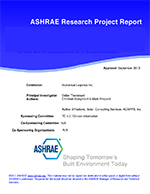Description
This study is part of an ASHRAE program aimed at investigating the potential link between perceived health symptoms and discomfort on one hand, and aircraft cabin environmental conditions and human factors on the other. Such data were called for in the NRC report to Congress (2002), and are needed to support ASHRAE’s standard setting process. Part I of the project has used the results from past studies and a literature review to guide the development of a measurement system and protocol, and a survey tool. These tools were then pilot tested and validated on four commercial aircraft flights. Part II, which will be under separate contract, will utilize the validated measurement and survey tools to collect data on a statistical sample of aircraft types and routings, and relate the health and comfort survey results from passengers and crew to the air quality and environmental variables observed.
In the Part I study reported here, three carry-on instrument packages were developed. Two were suitcases designed to fit under passenger seats. The third package was used to make spatial measurements of air speed, temperature, and noise throughout the passenger cabin. The underseat instruments measured temperature, relative humidity, light intensity, motion (acceleration), ozone, carbon dioxide, carbon monoxide, fine particulate matter, volatile organic compounds and semivolatile organic compounds. The instruments are battery powered, independent of aircraft systems, and can be installed and put into operation in 5-10 minutes. The instruments were tested for electromagnetic interference and certified for use aboard commercial aircraft. Two interrelated questionnaires were developed to assess passenger and crew perceptions of health and comfort in the cabin environment.
Product Details
- Published:
- 2004
- Number of Pages:
- 337
- File Size:
- 1 file , 2.6 MB
- Product Code(s):
- D-22607




